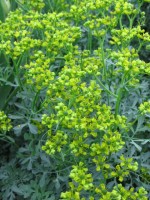 Also called herb of grace, rue is an evergreen mounding subshrub and a member of the Rutaceae family that also includes oranges, limes, and skimmia. It is native to the Balkan Peninsula where it grows on dry hillsides, often on limestone. Growing up to 3’ tall, the plant has a woody base and blue-green pinnately compound leaves 3-5” long with oblong to spatulate leaftlets. The leaflets are fleshy, dotted with glands, and are very aromatic when crushed. The dull yellow flowers have 4-5 petals, are ¾” across, and appear in flattened corymbs in early summer. Plants are usually grown for the attractive foliage and are popular in herb and rose gardens. Historically used as a medicinal herb, the problems associated with its use have led to its cultivation as an ornamental instead. The leaves are toxic if ingested and can photosensitize the skin causing watery blisters on sensitive individuals. The genus name, Ruta, may be related to the Greek word reuo meaning set free and refers to the healing power of the plant. The specific epithet, gravolens, probably is related to the Latin word gravis meaning heavy, and refers to the scent.
Also called herb of grace, rue is an evergreen mounding subshrub and a member of the Rutaceae family that also includes oranges, limes, and skimmia. It is native to the Balkan Peninsula where it grows on dry hillsides, often on limestone. Growing up to 3’ tall, the plant has a woody base and blue-green pinnately compound leaves 3-5” long with oblong to spatulate leaftlets. The leaflets are fleshy, dotted with glands, and are very aromatic when crushed. The dull yellow flowers have 4-5 petals, are ¾” across, and appear in flattened corymbs in early summer. Plants are usually grown for the attractive foliage and are popular in herb and rose gardens. Historically used as a medicinal herb, the problems associated with its use have led to its cultivation as an ornamental instead. The leaves are toxic if ingested and can photosensitize the skin causing watery blisters on sensitive individuals. The genus name, Ruta, may be related to the Greek word reuo meaning set free and refers to the healing power of the plant. The specific epithet, gravolens, probably is related to the Latin word gravis meaning heavy, and refers to the scent.
Type: Evergreen subshrub
Bloom: Dull yellow flowers ¾” across, with 4-5 petals, in flattened corymbs in early summer.
Size: 2-3’ H x 2-3’ W
Light: Full sun; tolerate some light shade.
Soil: Average to lean, dry to medium moist, well-drained,
Hardiness: Zones 4-9
Care: Cut back old growth to woody stems in early spring; mulch in cold winters.
Pests and Diseases: None of significance in most climates but root rot may be a problem in wet soil or in warm climates.
Propagation: Seed, terminal cuttings in late summer and early fall
Companion Plants: Roses, other herbs
Outstanding Selections:
‘Blue Beauty’ (18” tall)
‘Jackman’s Blue’ (30” tall; especially attractive glaucus blue foliage)